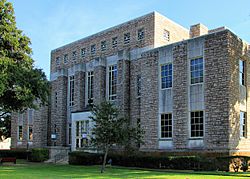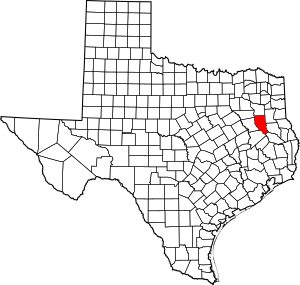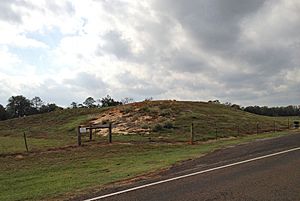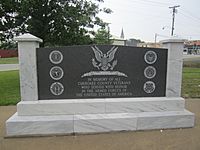Cherokee County, Texas facts for kids
Quick facts for kids
Cherokee County
|
|
|---|---|

The Cherokee County Courthouse in Rusk
|
|

Location within the U.S. state of Texas
|
|
 Texas's location within the U.S. |
|
| Country | |
| State | |
| Founded | July 13, 1846 |
| Named for | Cherokee people |
| Seat | Rusk |
| Largest city | Jacksonville |
| Area | |
| • Total | 1,062 sq mi (2,750 km2) |
| • Land | 1,053 sq mi (2,730 km2) |
| • Water | 9.3 sq mi (24 km2) 0.9% |
| Population
(2020)
|
|
| • Total | 50,412 |
| • Density | 47.469/sq mi (18.328/km2) |
| Time zone | UTC−6 (Central) |
| • Summer (DST) | UTC−5 (CDT) |
| Congressional district | 6th |
Cherokee County is a county located in the U.S. state of Texas. As of the 2020 census, its population was 50,412. The county seat is Rusk, which lies 130 miles southeast of Dallas and 160 miles north of Houston. The county was named for the Cherokee, who lived in the area before being expelled in 1839. Cherokee County comprises the Jacksonville micropolitan statistical area, which is also included in the Tyler–Jacksonville combined statistical area.
Contents
History
Native Americans

The Hasinai group of the Caddo tribe built a village in the area in around AD 800 and continued to live in the area until the 1830s, when they migrated to the Brazos River. The federal government moved them to the Brazos Indian Reservation in 1855 and later to Oklahoma.
The Cherokee, Delaware, Shawnee, and Kickapoo Native American peoples began settling in the area around 1820. The Texas Cherokee tried unsuccessfully to gain a grant to their own land from the Mexican government.
Sam Houston, adopted son of Chief Oolooteka (John Jolly) of the Cherokee, negotiated the January 14, 1836, treaty between Chief Bowl of the Cherokee and the Republic of Texas. On December 16, 1837, the Texas Senate declared the treaty null and void, and encroachment upon Cherokee lands continued. On October 5, 1838, Indians massacred members of the Isaac Killough family at their farm northwest of the site of present Jacksonville, leading to the Cherokee War of 1839 and the expulsion of some to Oklahoma. Some went to Monclova in Mexico, and some to Rusk and Gregg counties (many had relatives among the Choctaw/Chickasaw/Creek community there). Later, in 1844, President Polk issued an executive order known as "The Right to return", allowing many Cherokee to return to Texas. Some came to what is now Cherokee County.
Early exploration and settlers
Domingo Terán de los Ríos and Father Damián Massanet explored the area on behalf of Spain in 1691. Louis Juchereau de St. Denis began trading with the Hasinais in 1705. Nuestro Padre San Francisco de los Tejas was originally established in 1690, but was re-established in 1716 by Captain Domingo Ramon. It was abandoned again because of French incursions and re-established in 1721 by the Marques de San Miguel de Aguyao.
In 1826, empresario David G. Burnet received a grant from the Coahuila y Tejas legislature to settle 300 families. The settlers were mostly from the Southern states, and brought the lifestyle of that region with them. By contracting how many families each grantee could settle, the government sought to have some control over colonization.
County established and growth

Cherokee County was formed from land given by Nacogdoches County in 1846. It was organized in the same year. The town of Rusk became the county seat. Cherokee County voted in favor of secession from the Union, during the build-up to the American Civil War.
In 1872, the International – Great Northern Railroad caused Jacksonville to relocate two miles east, to be near the tracks. The Kansas and Gulf Short Line Railway was built north-to-south through the county between 1882 and 1885. The Texas and New Orleans Railroad in 1905, and the Texas State Railroad in 1910, each gave rise to new county towns along their tracks.
Geography
According to the U.S. Census Bureau, the county has a total area of 1,062 square miles (2,750 km2), of which 1,053 square miles (2,730 km2) is land and 9.3 square miles (24 km2) (0.9%) is covered by water.
Major highways
 U.S. Highway 69
U.S. Highway 69 U.S. Highway 79
U.S. Highway 79 U.S. Highway 84
U.S. Highway 84 U.S. Highway 175
U.S. Highway 175 State Highway 21
State Highway 21 State Highway 110
State Highway 110 State Highway 135
State Highway 135 State Highway 204
State Highway 204 State Highway 294
State Highway 294
Adjacent counties
- Smith County (north)
- Rusk County (northeast, east)
- Nacogdoches County (east, southeast)
- Angelina County (southeast)
- Houston County (southwest)
- Anderson County (west)
- Henderson County (northwest)
National protected area
- Neches River National Wildlife Refuge (part)
Communities
Cities
- Gallatin
- Jacksonville
- New Summerfield
- Reklaw (partly in Rusk County)
- Rusk (county seat)
- Troup (mostly in Smith County)
Towns
- Alto
- Bullard (mostly in Smith County)
- Cuney
- Wells
Census-designated place
Unincorporated communities
- Blackjack
- Central High
- Circle
- Concord
- Cove Springs
- Craft
- Dialville
- Elm Grove
- Forest
- Gould
- Henry's Chapel
- Ironton
- Linwood
- Maydelle
- Mixon
- Mount Selman
- New Hope
- Oakland
- Pine Grove
- Ponta
- Reese
- Salem
- Shady Grove
- Sweet Union
- Weeping Mary
Ghost towns
- Atoy
- Brunswick
- Bulah
- Corine
- Earle's Chapel
- Emmaus
- Etna
- Griffin
- Java
- Larissa
- Lone Star
- Mewshaw
- Morrill
- New Birmingham
- Pierces Chapel
- Prices
- Redlawn
- Rock Hill
- Tecula
- Turney
- Wildhurst
Demographics
| Historical population | |||
|---|---|---|---|
| Census | Pop. | %± | |
| 1850 | 6,673 | — | |
| 1860 | 12,098 | 81.3% | |
| 1870 | 11,079 | −8.4% | |
| 1880 | 16,723 | 50.9% | |
| 1890 | 22,975 | 37.4% | |
| 1900 | 25,154 | 9.5% | |
| 1910 | 29,038 | 15.4% | |
| 1920 | 37,633 | 29.6% | |
| 1930 | 43,180 | 14.7% | |
| 1940 | 43,970 | 1.8% | |
| 1950 | 38,694 | −12.0% | |
| 1960 | 33,120 | −14.4% | |
| 1970 | 32,008 | −3.4% | |
| 1980 | 38,127 | 19.1% | |
| 1990 | 41,049 | 7.7% | |
| 2000 | 46,659 | 13.7% | |
| 2010 | 50,845 | 9.0% | |
| 2020 | 50,412 | −0.9% | |
| U.S. Decennial Census 1850–2010 2010 2020 |
|||
| Race / Ethnicity (NH = Non-Hispanic) | Pop 2000 | Pop 2010 | Pop 2020 | % 2000 | % 2010 | % 2020 |
|---|---|---|---|---|---|---|
| White alone (NH) | 32,347 | 31,892 | 30,095 | 69.33% | 62.72% | 59.70% |
| Black or African American alone (NH) | 7,409 | 7,401 | 6,359 | 15.88% | 14.56% | 12.61% |
| Native American or Alaska Native alone (NH) | 143 | 125 | 128 | 0.31% | 0.25% | 0.25% |
| Asian alone (NH) | 177 | 221 | 263 | 0.38% | 0.43% | 0.52% |
| Pacific Islander alone (NH) | 8 | 6 | 18 | 0.02% | 0.01% | 0.04% |
| Other Race alone (NH) | 17 | 36 | 123 | 0.04% | 0.07% | 0.24% |
| Mixed Race or Multiracial (NH) | 380 | 665 | 1,629 | 0.81% | 1.31% | 3.23% |
| Hispanic or Latino (any race) | 6,178 | 10,499 | 11,797 | 13.24% | 20.65% | 23.40% |
| Total | 46,659 | 50,845 | 50,412 | 100.00% | 100.00% | 100.00% |
At the 2000 United States census there were 46,659 people, 16,651 households, and 12,105 families resided in the county. The population density was 44 people per square mile (17 people/km2). The 19,173 housing units averaged 18 units per square mile (6.9/km2). The racial and ethnic makeup of the county was 74.34% White, 15.96% Black or African American, 0.47% Native American, 0.40% Asian, 0.06% Pacific Islander, 7.43% from other races, and 1.34% from two or more races. About 13.24% of the population was Hispanic or Latino of any race. By 2020, its population increased to 50,412. The racial and ethnic makeup at the 2020 United States census was 59.70% non-Hispanic white, 12.61% Black or African American, 0.25% American Indian and Alaska Native, 0.52% Asian, 0.04% Pacific Islander, 0.24% some other race, 3.23% two or more races, and 23.40% Hispanic or Latino of any race. The increase among its Hispanic and Asian American populations represented the nationwide demographic shift since the 2020 census.
Of the 16,651 households in 2000, 33.40% had children under the age of 18 living with them, 55.70% were married couples living together, 12.80% had a female householder with no husband present, and 27.30% were not families. Around 24.20% of all households were made up of individuals, and 11.90% had someone living alone who was 65 years of age or older. The average household size was 2.63, and the average family size was 3.11. In 2020 according to the American Community Survey, there were 18,540 households with an average household size of 2.65 and average family size of 3.07.
At the 2000 census, the median income for a household in the county was $29,313, and for a family was $34,750. Males had a median income of $26,410 versus $19,788 for females. The per capita income for the county was $13,980. About 13.70% of families and 17.90% of the population were below the poverty line, including 23.30% of those under age 18 and 15.10% of those age 65 or over. The 2020 American Community Survey's estimates determined there was a median household income of $50,199 with a per capita income of $66,658.
Media
Cherokee County is part of the Tyler/Longview/Jacksonville DMA. Local media outlets are: KLTV, KTRE-TV, KYTX-TV, KFXK-TV, KCEB-TV, and KETK-TV.
Newspapers in the county include the Jacksonville Progress, which publishes three editions a week in Jacksonville, and the weekly Cherokeean Herald in Rusk.
Education
School districts within Cherokee County Texas include the following:
- Alto Independent School District
- Bullard Independent School District
- Carlisle Independent School District
- Jacksonville Independent School District
- New Summerfield Independent School District
- Rusk Independent School District
- Troup Independent School District
- Wells Independent School District
Areas in Bullard, Jacksonville, New Summerfield, Rusk, and Troup are assigned to Tyler Junior College. Areas of Cherokee County in Alto ISD and Wells ISD are assigned to Angelina College. Areas in Carlisle ISD are assigned to Kilgore College. Legislation does not specify a community college for the remainder of the county.
See also
 In Spanish: Condado de Cherokee (Texas) para niños
In Spanish: Condado de Cherokee (Texas) para niños

